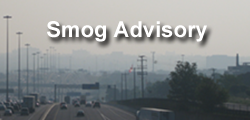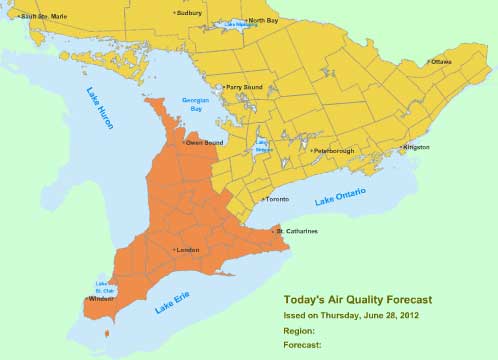
A SMOG ADVISORY* has been issued by the Ontario Ministry of the Environment for the following forecast regions for June 28:
- City of Hamilton
- Dunnville-Caledonia-Haldimand
- Elgin
- Grey-Bruce
- Huron-Perth
- London-Middlesex
- Niagara
- Oxford-Brant
- Sarnia-Lambton
- Simcoe-Delhi-Norfolk
- Waterloo-Wellington
- Windsor-Essex-Chatham-Kent

Hot, sunny conditions, combined with a west to southwesterly flow of polluted air from the U.S. and local build-up of pollutants are forecasted to result in elevated smog levels across parts of southern and western Ontario.
A smog advisory is in effect for Southern & Western Ontario:
- This advisory will remain in effect until further notice.
* A Smog Advisory means that there is a strong likelihood that there may be poor air quality within the next 24 hours due to ground-level ozone and/or particulate matter.
- It is an indicator of air quality, based on air pollutants that have adverse effects on human health and the environment.
- Smog is harmful to the lungs and heart.
- Even in healthy people, smog can reduce lung function.

- A Smog Advisory is related to the Air Quality Index (AQI), which rates how clean the air is.
- The AQI scale ranges from 0 to 100+.
- Higher numbers mean higher health risks.
- A Smog Advisory is issued in your region when the AQI is expected to reach 50 in the next 24 hours.
- It can be lifted once the AQI is expected to reach or drops below 50.
- Smog is made up of a complex mixture of air pollutants that are sometimes visible, such as a brownish-yellow haze over cities; sometimes not.
- The two main ingredients of smog are ground-level ozone (O3) and fine particulate matter (PM2.5).
Hot, sunny conditions, combined with a southwesterly flow of polluted air from the U.S. and local build-up of pollutants are resulting in elevated smog levels across southern, central, and parts of northern and eastern Ontario.
The details of the smog forecast are as follows:
- During Thursday:
- A weak high pressure ridge moving eastward over eastern Ontario is causing mostly sunny skies except for:
- some periods of cloudiness over some regions
- smoke from western forest fires causing hazy skies over many regions.
- A southwesterly flow of very warm and increasingly humid air is causing increasing temperatures with light south to southwesterly winds.
- A weak low pressure trough is forecasted to move eastward across southern Ontario overnight and to be east of the province by Friday morning.
- Air quality indices are forecasted to:
- increase to the poor category in the smog advisory regions, mostly due to ozone, and to be in the good to moderate categories elsewhere
- A weak high pressure ridge moving eastward over eastern Ontario is causing mostly sunny skies except for:
- During Friday:
- A weak high pressure ridge over the Great Lakes region is forecasted to cause mostly sunny skies over most of the forecast regions
- Very warm temperatures are forecasted to continue with lower humidity and west to northwesterly winds.
- Similarly, air quality indices are forecasted to:
- increase to the poor category in the smog advisory regions, mostly due to ozone, and to be in the good to moderate categories elsewhere
- During Saturday:
- Very warm temperatures are forecasted to continue with partly or mostly sunny skies during the morning and west to southwesterly winds ahead of a weak cold front.
- The front is forecasted to move eastward over northern and southern Ontario during the afternoon, followed by winds veering to northwesterly.
- Similarly, air quality indices are forecasted to:
- increase to the poor category in the smog advisory regions, mostly due to ozone, and to be in the good to moderate categories elsewhere
During the smog episode, individuals may experience the following symptoms:
- eye irritation
- heavy outdoor exercise may cause respiratory symptoms such as coughing or shortness of breath
- people with heart or lung disease including asthma may experience a worsening of their condition
Please click here for details on air quality in Ontario.
Spare the Air Actions
During a smog advisory, there are a number of actions that you can take to help spare the air.
Travel tips – all year round:
- leave your car at home – walk, cycle, carpool or take public transit
- tele-conference instead of driving to meetings
- limit car trips by doing all your errands at once, and do not let your engine idle
- keep your car well tuned, check your tire pressure and drive at moderate speeds
Health tips:
- avoid exposure to vehicle exhaust fumes
- consult your doctor for specific health advice
- wear light clothing at work while air conditioning is reduced
- avoid strenuous exercise in the heat of the day
Electricity saving tips:
- save electricity at home by setting your air conditioner temperature a few degrees higher (health permitting) and
- turning off lights you are not using
Other pollution reduction tips:
- leave lawn mowing for another day
- restrict the use of gasoline-powered equipment
- delay using oil-based paints, solvents and cleaners
Please click on the following text to:
Please click here for more info about smog.
————————————–—
You may also want to know:
